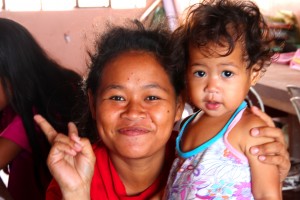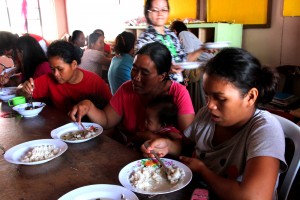
Her cheeky grin and the loving way she nurtures her baby belie Rohelyn Pulalo’s struggles. In less than a year, she and her family, including her children ages 5, 3, and 1 found themselves fleeing from two warzones.
A few months ago, it was Rohelyn’s first time to step in the Philippines. Having lived in Sabah, Malaysia, all her life, she was nonetheless forced to go to Zamboanga because of the armed conflict between the troops of Sultan Jamalul Kiram III and the Malaysian security forces.
A few months later, she found herself fleeing again – this time because of the armed conflict between the Muslim National Liberation Front (MNLF) and the military. As she said, “Galing kaming Malaysia. Pagdating naman namin dito, nag-giyera pa rin .”
While she shared that she remembered nothing of her flight from Sabah other than the feeling of terror, Rohelyn could recall that night her family fled their home in Santa Catalina on September 9, the first day of the conflict. “May pumutok nang alas singko ng umaga. Iyong mga tao, nagtakbuhan. Kami rin tumakbo kasi nakarinig na kami ng putok. Dumaaan kami sa Tetuan, maputik pa doon .”
She continued, “Hindi kami nakadala ng gamit. Sarili lang ang nadala namin at ang mga bata. Iyong isa kinarga ko. Iyong dalawa, iyong asawa ko naman .” During that time, Rohelyn was already four months’ pregnant, but fear kept her running as fast as she could with her husband to protect their children.
Since the time they fled, their family has yet to go back to their house. Instead, for a month now, they have made a temporary home out of one of the many evacuation centers set up by the Department of Social Welfare and Development (DSWD) and the local government unit in Zamboanga City. They, like 64 other families, are staying at the Zamboanga City High School – West.
As of October 15, there are 9,197 families with 41,398 persons in 29 evacuation centers spread all over the city.
Rohelyn shared her fear the day they fled their house on September 9, 2013, the start of the Zamboanga city siege. “Natakot talaga ako kasi nagpaputok na sila.Ngayon bumuti na ang pakiramdam namin dahil alam na naming safe na kami dito .”
While her husband lined up in the JFE Sports Complex to get some lunch, Rohelyn, being pregnant, qualifies as a partner-beneficiary of the Supplemental Feeding Program, which is part of the DSWD’s response to the aftermath of the armed conflict and flooding in Zamboanga City.
The food given to those who are part of the Supplemental Feeding Program is identified by the DSWD’s nutritionist, who works with some volunteers to prepare the meals at the community kitchen set up in the evacuation center.

Food preparation starts at 9:00 a.m. daily, once the nutritionist returns to the evacuation center after going to the market to buy food items. From 12:00 to 1:30 p.m. the meals are then served to the partner-beneficiaries of the Supplemental Food Program.
“Masarap ang pagkain dito kesa sa bahay namin ,” Rohelyn said, grinning. She shared that the DSWD has played a large role in her life recently, not only through the evacuation center and the feeding program, but also when it provided support when her family and the other refugees left Sabah.
Rohelyn shared that before they were forced to flee Sabah, her husband worked as a carpenter in Malaysia. When they moved to Zamboanga, it was her spouse’s turn to stay at home to take care of their children while Rohelyn worked as a vegetable vendor at the market. Because of the armed conflict, neither she nor her husband is unable to work anymore.
When asked what she wanted in life, she said, “Gusto ko lang mabigay iyong dating sa amin. Gusto kong mag-hanap-buhay uli. Iyon lang. Sana wala nang gulo .” ###


